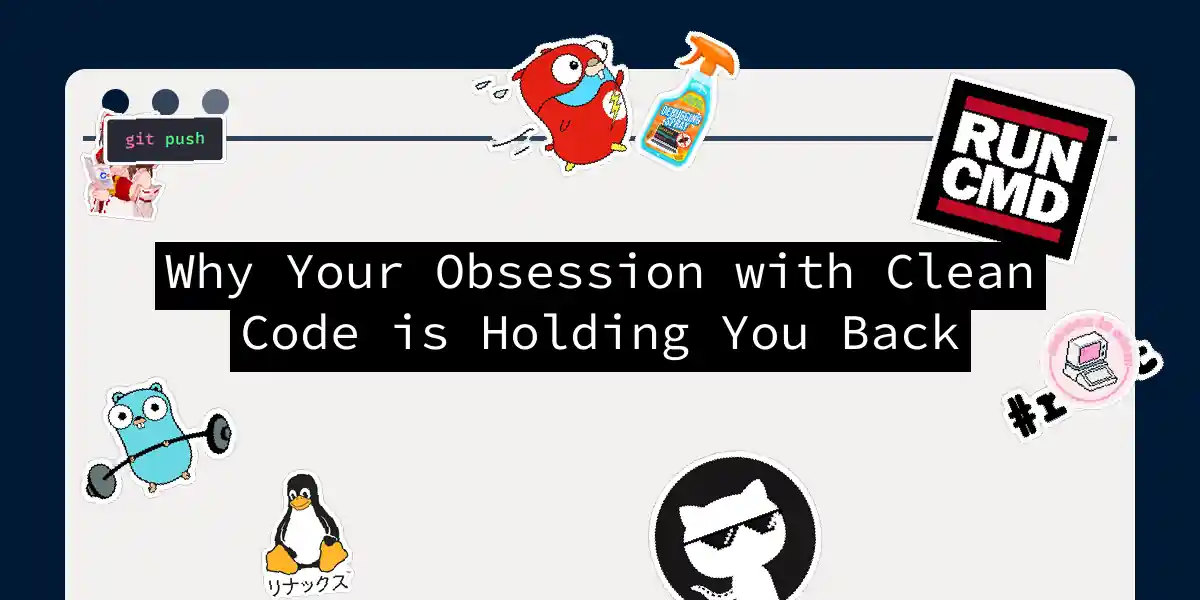The Allure and the Pitfall of Clean Code
Clean code is often touted as the holy grail of software development. It’s the promise of maintainable, efficient, and elegant code that makes every developer’s heart sing. However, there’s a fine line between striving for clean code and being obsessed with it. This obsession can lead to a plethora of problems that might just be holding you back from delivering value and meeting the real needs of your users.
The Cliff of Fragility and Rigidity
Imagine two cliffs: one of fragility and one of rigidity. On the cliff of fragility, you’re constantly saying “yes” to new features without a solid foundation, leading to legacy code that’s too scary to touch. On the cliff of rigidity, you’re so obsessed with clean code that you say “no” to everything that doesn’t fit your perfect vision, resulting in code that’s more theoretical than practical[1].
Symptom 1: When Principles Become Rules
Principles like DRY (Don’t Repeat Yourself) and YAGNI (You Ain’t Gonna Need It) are great guidelines, but they should not be treated as hard and fast rules. For instance, refactoring every single instance of code duplication can sometimes make your code less readable and more complex. Similarly, ignoring future requirements entirely can lead to poor design and significant refactoring later on[1].
Symptom 2: Arbitrary Rules
Setting arbitrary rules like “90% code coverage for every class” or “no more than 500 lines per file” can be counterproductive. These rules might make your code harder to change and less maintainable. Instead, they should serve as hints for discussion rather than rigid guidelines[1].
Symptom 3: Ignoring Functional Requirements
Clean code is not just about making the code look beautiful; it’s about meeting the functional requirements of your users. If your users are primarily using smartphones, optimizing your web application for desktops alone is a misstep. Clean code must balance between aesthetics and functionality[1].
Symptom 4: The Misconception of Simplicity
Simplicity is often misunderstood as the absence of complexity. However, simplicity in software development means making complex systems easy to use and understand. The Google search engine, for example, uses a simple text field to perform a multitude of complex tasks. The code behind it is not simple, but the user experience is[1].
Symptom 5: Binary Thinking
Code is not just clean or dirty; it exists in shades of grey. Refactoring code without understanding its context or the reasons behind its current state can be detrimental. It’s essential to view code as a spectrum rather than in binary terms[1].
Symptom 6: Overreliance on Frameworks
Frameworks can simplify your code and reduce boilerplate, but they do not guarantee clean code. Overreliance on the latest frameworks can distract you from the real task of delivering value to your users. Clean code can be achieved without any framework at all[1].
The Startup Dilemma
In the startup world, the pursuit of clean code can be particularly problematic. Here are a few reasons why:
Time is of the Essence
Startups operate under tight deadlines and need to iterate quickly. Spending too much time on code refactoring can delay crucial releases and give competitors an edge[3].
Limited Resources
Startups have limited financial and human resources. Every hour spent on refactoring is an hour not spent on developing new features or addressing customer needs[3].
Uncertain Future
Startups often pivot multiple times before finding their product-market fit. Investing heavily in clean code for features that may be discarded can be a waste of resources[3].
The Cost of Clean Code Obsession
Opportunity Cost
Every hour spent on refactoring existing code is an hour not spent on developing new features, acquiring customers, or improving the product based on user feedback. This opportunity cost can be significant and might mean missing out on critical market share[3].
Delayed Time-to-Market
Delays in shipping your product due to the pursuit of clean code can be costly. If your competitors launch first, you might lose valuable market share[3].
Premature Optimization
Spending time making code clean and efficient before validating your product can be a form of premature optimization. You might be solving problems you don’t have yet, at the expense of solving the immediate ones[3].
Perfectionism Paralysis
The pursuit of clean code can lead to perfectionism that paralyzes progress. Developers might become hesitant to ship code that doesn’t meet their high standards, even when it’s functional and solves the immediate problem[3].
Remedies for Clean Code Obsession
Learn More About Clean Code
Clean code is not just about following rules or best practices; it’s about understanding the nuances and making informed decisions. Reading books like “A Philosophy of Software Design” and “Domain-Driven Design” can provide a deeper understanding of what clean code truly means[1].
Read More Code
Reading a variety of codebases, especially open-source projects, can give you a realistic view of what clean code looks like in practice. It helps you understand that even widely used codebases have their imperfections and that clean code is not a one-size-fits-all solution[1].
Think More Globally
Remember why you’re writing code in the first place: to make the lives of your users easier. Shipping functional code that meets user needs is often more important than polishing every detail. “Shipping is a feature,” and it should not be overlooked in the pursuit of clean code[1].
Conclusion
Clean code is a valuable goal, but it should not become an obsession that hinders your ability to deliver value. By understanding the symptoms of clean code obsession and the remedies to address them, you can strike a balance between maintaining clean, efficient code and meeting the real-world needs of your users.
In the end, clean code is not about winning a beauty contest; it’s about creating software that is maintainable, efficient, and valuable to those who use it. So, the next time you’re tempted to refactor that piece of code for the umpteenth time, ask yourself: “Is this really making my users’ lives better, or am I just chasing a dream of perfection?”
